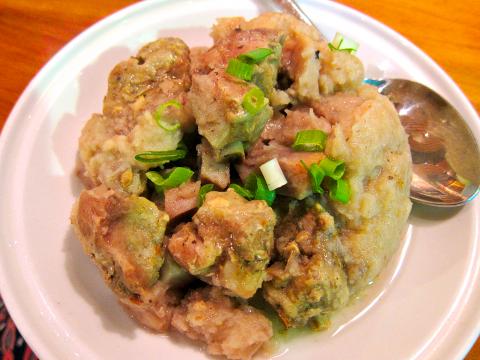The neighborhood around Yongkang Street (永康街) is packed with restaurants serving traditional Taiwanese cuisine. Fengsheng (豐盛食堂) stands out from its competitors, however, with its friendly service and simple but elegant decor, which shows off antiques collected in Miaoli County’s Sanyi Township (三義鄉).
Two back dining rooms for private parties were added last month. The centerpiece of the space is a set of antique carved wooden doors with windows that sport ingenious sliding shutters. A waitress was eager to show me the wooden mechanism at the bottom of each shutter that allows it to open or close with the flick of a finger. The main dining room, meanwhile, is decorated with two large panels made from brightly colored Taiwanese floral cloth.
Fengsheng’s menu is just as classic and thoughtful as its interior. Ingredients for its most popular dishes are shown off in a refrigerated display case and a giant picture menu on the wall highlights popular dishes, which makes ordering a snap.

Photo: Catherine Shu, Taipei Times
Pork dishes are especially good. My favorite was the hongzao braised pork (紅糟松阪肉, NT$180), which is first marinated in the bright red sediment left over from the production of Shaohsing rice wine (紹興酒). The thin slices of pork shoulder are amply veined with fat and have a very slightly chewy texture, while the hongzao marinade lends the meat a full-bodied, robust flavor.
The dried vegetable pork (菜乾肉, NT$160) is made with sprigs of dried cauliflower stewed and then served with chunks of pork. The cauliflower, firm and a bit crunchy, soaks up the rich, savory sauce and is complemented well by the tender, fatty chunks of pork.
Another pork dish, but with a completely different set of flavors and textures, is the taro root ribs (芋頭排骨, NT$160). The braised ribs, cooked until the meat slides off the bone, are nestled on top of a mound of mashed taro root. I wondered if the taro root would be too mushy to work well with the tender meat, but its soft, slightly grainy texture and sweet, mellow flavor actually provided a good contrast.
One of Fengsheng’s best-selling seafood dishes is the garlic paste oysters (蒜泥蚵, NT$160). The small, plump shellfish are lightly stir-fried and then drenched in a very pungent garlic sauce. The dish is served with a giant heap of ginger slices and at first the competing flavors — briny oysters, biting garlic and snappy ginger — were jarring. But after a few bites, they began to settle in and blend pleasingly together.
The other two seafood dishes I tried were good, but not particularly memorable. The juicy, plump meat of the steamed milkfish fillets (煎虱目魚肚, NT$180) was delicately sweet, especially when drizzled with a little bit of lime juice, while the five flavor calamari (五味中卷, NT$160) was cooked just right and tasted delicious when dipped in cocktail sauce and wasabi. Similar versions of both dishes, however, can be found in plenty of restaurants.

Nov. 11 to Nov. 17 People may call Taipei a “living hell for pedestrians,” but back in the 1960s and 1970s, citizens were even discouraged from crossing major roads on foot. And there weren’t crosswalks or pedestrian signals at busy intersections. A 1978 editorial in the China Times (中國時報) reflected the government’s car-centric attitude: “Pedestrians too often risk their lives to compete with vehicles over road use instead of using an overpass. If they get hit by a car, who can they blame?” Taipei’s car traffic was growing exponentially during the 1960s, and along with it the frequency of accidents. The policy

Hourglass-shaped sex toys casually glide along a conveyor belt through an airy new store in Tokyo, the latest attempt by Japanese manufacturer Tenga to sell adult products without the shame that is often attached. At first glance it’s not even obvious that the sleek, colorful products on display are Japan’s favorite sex toys for men, but the store has drawn a stream of couples and tourists since opening this year. “Its openness surprised me,” said customer Masafumi Kawasaki, 45, “and made me a bit embarrassed that I’d had a ‘naughty’ image” of the company. I might have thought this was some kind

What first caught my eye when I entered the 921 Earthquake Museum was a yellow band running at an angle across the floor toward a pile of exposed soil. This marks the line where, in the early morning hours of Sept. 21, 1999, a massive magnitude 7.3 earthquake raised the earth over two meters along one side of the Chelungpu Fault (車籠埔斷層). The museum’s first gallery, named after this fault, takes visitors on a journey along its length, from the spot right in front of them, where the uplift is visible in the exposed soil, all the way to the farthest

The room glows vibrant pink, the floor flooded with hundreds of tiny pink marbles. As I approach the two chairs and a plush baroque sofa of matching fuchsia, what at first appears to be a scene of domestic bliss reveals itself to be anything but as gnarled metal nails and sharp spikes protrude from the cushions. An eerie cutout of a woman recoils into the armrest. This mixed-media installation captures generations of female anguish in Yun Suknam’s native South Korea, reflecting her observations and lived experience of the subjugated and serviceable housewife. The marbles are the mother’s sweat and tears,